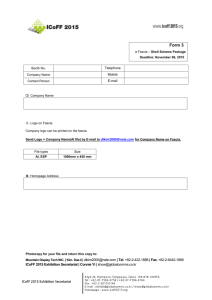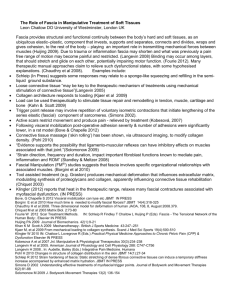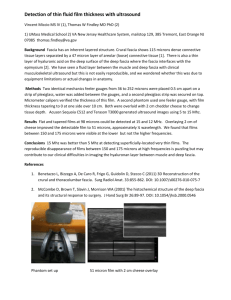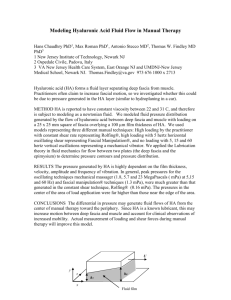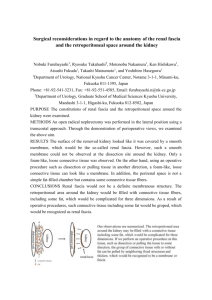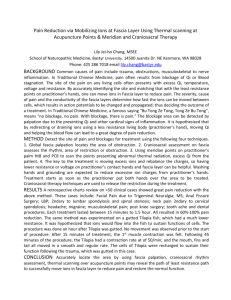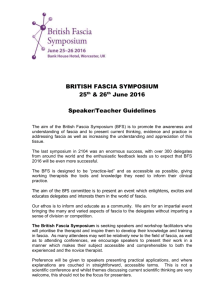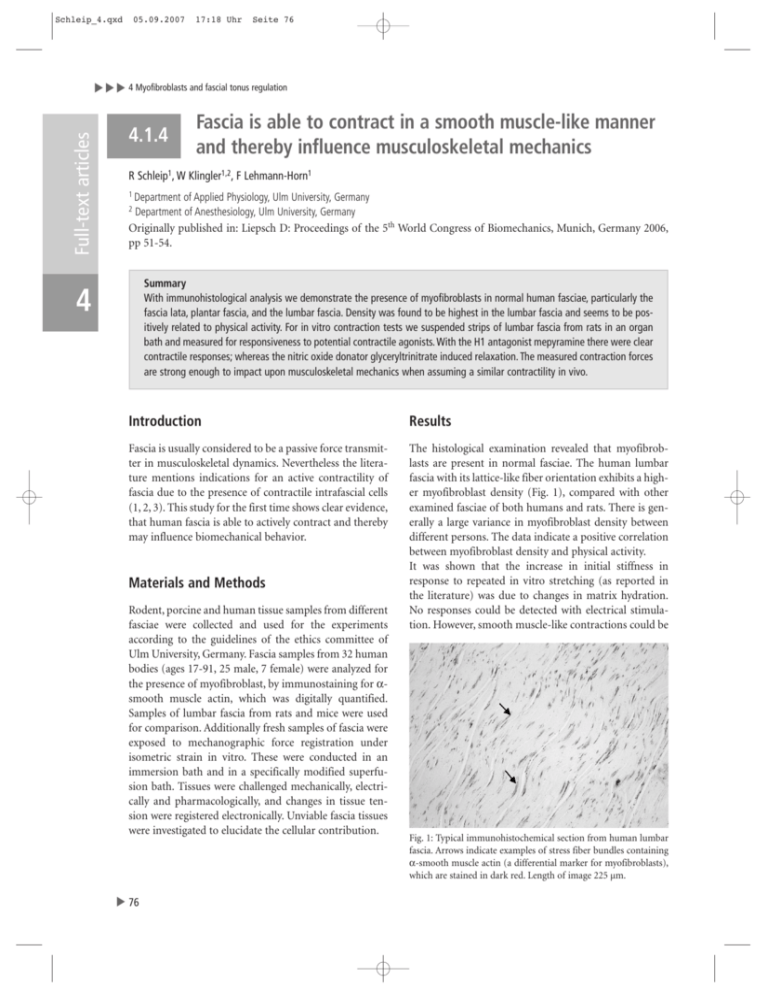
▼
▼
▼
Schleip_4.qxd
05.09.2007
Seite 76
4 Myofibroblasts and fascial tonus regulation
4.1.4
Full-text articles
17:18 Uhr
Fascia is able to contract in a smooth muscle-like manner
and thereby influence musculoskeletal mechanics
R Schleip1, W Klingler1,2, F Lehmann-Horn1
1 Department
2
of Applied Physiology, Ulm University, Germany
Department of Anesthesiology, Ulm University, Germany
Originally published in: Liepsch D: Proceedings of the 5th World Congress of Biomechanics, Munich, Germany 2006,
pp 51-54.
Summary
With immunohistological analysis we demonstrate the presence of myofibroblasts in normal human fasciae, particularly the
fascia lata, plantar fascia, and the lumbar fascia. Density was found to be highest in the lumbar fascia and seems to be positively related to physical activity. For in vitro contraction tests we suspended strips of lumbar fascia from rats in an organ
bath and measured for responsiveness to potential contractile agonists. With the H1 antagonist mepyramine there were clear
contractile responses; whereas the nitric oxide donator glyceryltrinitrate induced relaxation. The measured contraction forces
are strong enough to impact upon musculoskeletal mechanics when assuming a similar contractility in vivo.
4
Introduction
Results
Fascia is usually considered to be a passive force transmitter in musculoskeletal dynamics. Nevertheless the literature mentions indications for an active contractility of
fascia due to the presence of contractile intrafascial cells
(1, 2, 3). This study for the first time shows clear evidence,
that human fascia is able to actively contract and thereby
may influence biomechanical behavior.
The histological examination revealed that myofibroblasts are present in normal fasciae. The human lumbar
fascia with its lattice-like fiber orientation exhibits a higher myofibroblast density (Fig. 1), compared with other
examined fasciae of both humans and rats. There is generally a large variance in myofibroblast density between
different persons. The data indicate a positive correlation
between myofibroblast density and physical activity.
It was shown that the increase in initial stiffness in
response to repeated in vitro stretching (as reported in
the literature) was due to changes in matrix hydration.
No responses could be detected with electrical stimulation. However, smooth muscle-like contractions could be
Materials and Methods
▼
Rodent, porcine and human tissue samples from different
fasciae were collected and used for the experiments
according to the guidelines of the ethics committee of
Ulm University, Germany. Fascia samples from 32 human
bodies (ages 17-91, 25 male, 7 female) were analyzed for
the presence of myofibroblast, by immunostaining for αsmooth muscle actin, which was digitally quantified.
Samples of lumbar fascia from rats and mice were used
for comparison. Additionally fresh samples of fascia were
exposed to mechanographic force registration under
isometric strain in vitro. These were conducted in an
immersion bath and in a specifically modified superfusion bath. Tissues were challenged mechanically, electrically and pharmacologically, and changes in tissue tension were registered electronically. Unviable fascia tissues
were investigated to elucidate the cellular contribution.
76
Fig. 1: Typical immunohistochemical section from human lumbar
fascia. Arrows indicate examples of stress fiber bundles containing
α-smooth muscle actin (a differential marker for myofibroblasts),
which are stained in dark red. Length of image 225 µm.
Schleip_4.qxd
05.09.2007
17:18 Uhr
Seite 77
▼
▼
▼
4.1 Full-text articles
induced pharmacologically. High dosages of the antihistaminic substance mepyramine had most reliable and sustaining effects (n=29, p<0.05); while histamine and oxytocin induced shorter contractile responses in selected
fasciae only; and addition of an NO donator triggered
brief relaxation responses in several samples. No response
could be elicited with epinephrine, acetylcholine, and
adenosine. The mepyramine induced tissue contractions
demonstrated very slow and enduring response curves,
lasting up to 2 h (Fig. 2). Since the histological examination had revealed an increased myofibroblast density in
endo- and perimysial intramuscular fasciae (4), mepyramine was additionally applied to whole muscular tissue
pieces including their fasciae, which showed similar contractile response curves as pure fascia, apparently not due
to myogenic contraction.
The maximal in vivo contraction forces were hypothetically calculated and applied to the human lumbar area.
The resulting forces are strong enough to alter normal
musculoskeletal behavior, such as mechanical joint stabilization or γ-motor regulation.
Conclusions
These results suggest, that fascia is a contractile organ,
due to the presence of myofibroblasts. This ability is
expressed on the one hand in chronic tissue contractures
which include tissue remodeling; and on the other hand
in smooth muscle-like cellular contractions over a time
Full-text articles
Fig. 2: Typical response curve of fascia to
mepyramine. A bundle of rat lumbar fascia is
exposed to 250 × 10-3M mepyramine in a
superfusion organ bath. To allow optimal tissue
saturation with the substance, the constant
Krebs-Ringer (KR) irrigation is interrupted
2 min before substance addition (Mep) and
restarted again 2 min afterwards. The brief initial force increase is due to temporary weight
gain of the tissue due to the mepyramine solution, which is then quickly washed off. Note the
slow and sustained duration of the reaction, a
typical feature of fascial tissue response to
mepyramine.
4
frame of minutes to hours, which can be strong enough
to influence low back stability and other aspects of
human biomechanics. This offers future implications for
the understanding and clinical management of pathologies which go along with increased or decreased myofascial stiffness (such as low back pain, tension headache,
spinal instability, or fibromyalgia). It also offers new
insights for treatments directed at fascia, such as osteopathy, the Rolfing method of myofascial release, or
acupuncture. Further research on fascial contractility is
indicated and promising.
This study has been supported by grants from the
International Society of biomechanics (USA), the Rolf
Institute of Structural Integration (USA), and the
European Rolfing Association e.V. (Germany).
References
(1) Yahia LH, Pigeon P, DesRosiers EA: Viscoelastic properties of the
human lumbodorsal fascia. J Biomed Eng 15: 425-429 (1993)
(2) Staubesand J, Li Y: Zum Feinbau der Fascia cruris mit besonderer
Berücksichtigung epi- und intrafaszialer Nerven. Manuelle Medizin 34:
196-200 (1996)
(3) Schleip R, Klingler W, Lehmann-Horn F: Active fascial contractility:
fascia may be able to contract in a smooth muscle-like manner and
thereby influence musculoskeletal dynamics. Med Hypotheses 65: 273277 (2005)
(4) Schleip R, Naylor IL, Ursu D, Melzer W, Zorn A, Wilke HJ, LehmannHorn F, Klingler W: Passive muscle stiffness may be influenced by active
contractility of intramuscular connective tissue. Med Hypotheses 66:
66-71 (2006)
▼
77
Basic Science and Implications
for Conventional and
Complementary Health Care
Thomas W. Findley and Robert Schleip, Editors
Schleip_Titelei.qxd
05.09.2007
17:03 Uhr
Seite 4
All business correspondence should be made with:
Elsevier GmbH, Urban & Fischer Verlag, Karlstraße 45, 80333 Munich, Germany
Notice for the reader
The editors, authors and the publisher of this work have made every effort to ensure that the drug dosage schedules
herein are accurate and in accord with the standards accepted at the time of publication. The reader is strongly advised,
however, to check the product information sheet included in the package of each drug he or she plans to administer to
be certain that changes have not been made in the recommended dose or in the contraindications for administration.
Bibliographic information published by the Deutsche Nationalbibliothek
The Deutsche Nationalbibliothek lists this publication in the Deutsche Nationalbibliografie; detailed bibliographic data
are available in the Internet at http://dnb.d-nb.de.
All rights reserved
First published 2007
© Elsevier GmbH, Munich 2007
Responsibility for content and permissions for republication is with the editors.
Urban & Fischer Verlag is an imprint of Elsevier GmbH.
07 08 09 10 11
5 4 3 2 1
All rights, including translation, are reserved. No part of this publication may be reproduced, stored in a retrieval system, or transmitted in any other form or by any means, electronic, mechanical, photocopying, recording, or otherwise
without the prior written permission of the publisher.
Editor: Christl Kiener, Munich
Production Manager: Antje Arnold, Munich
Composed by: Kadja Gericke, proprint Arnstorf
Printed and bound by: Cadmus Communications, Lancaster PA
Cover illustration and design: Ilene Hass, Creative Solutions, Elkins Park PA
Printed in USA
ISBN: 978-3-437-55009-6
Current information by www.elsevier.de and www.elsevier.com

